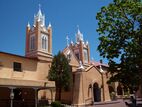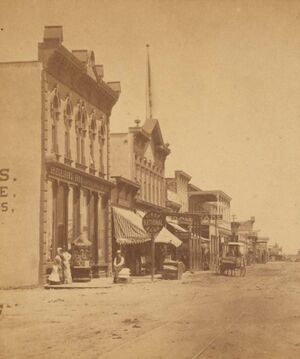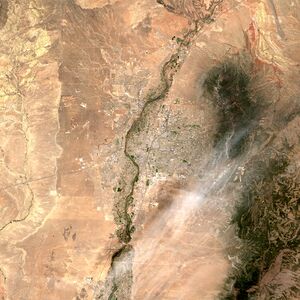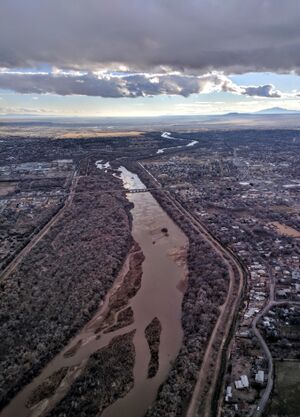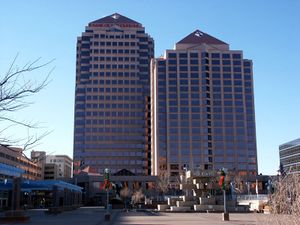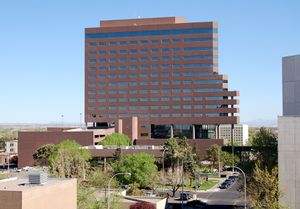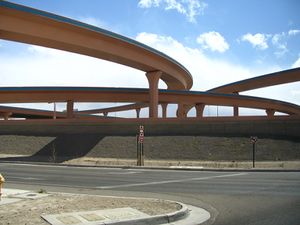ألباكركي، نيو مكسيكو
Albuquerque | |
|---|---|
|
| |
| الكنية: The Duke City, ABQ, The 505, Burque, The Q. | |
 Interactive map of Albuquerque | |
| الإحداثيات: 35°06′39″N 106°35′36″W / 35.11083°N 106.59333°W | |
| Country | United States |
| State | New Mexico |
| County | Bernalillo |
| Metropolitan area | Albuquerque metropolitan area |
| Founded | 1706 (as Alburquerque) |
| Incorporated | 1891 (as Albuquerque) |
| أسسها | Francisco Cuervo y Valdés |
| السمِيْ | Francisco Fernández de la Cueva, Duke of Alburquerque |
| الحكومة | |
| • النوع | Mayor–council government |
| • Mayor | Tim Keller (D) |
| • City Council | Councilors
|
| • State House | Representatives
|
| • State Senate | State senators
|
| • U.S. House | Melanie Stansbury (D) Gabe Vasquez (D) |
| المساحة | |
| • City | 188٫95 ميل² (489٫39 كم²) |
| • البر | 187٫27 ميل² (485٫03 كم²) |
| • الماء | 1٫68 ميل² (4٫36 كم²) |
| المنسوب | 4٬967 ft (1٬514 m) |
| التعداد | |
| • City | 572٬864 |
| • الترتيب | 85th in North America 32nd in the United States 1st in New Mexico |
| • الكثافة | 3٬014٫68/sq mi (1٬163٫97/km2) |
| • Urban | 769٬837 (US: 59th) |
| • الكثافة الحضرية | 2٬926٫3/sq mi (1٬129٫9/km2) |
| • العمرانية | 955٬000 (US: 61st) |
| صفة المواطن | Burqueño, Burqueña |
| منطقة التوقيت | UTC−7 (MST) |
| • الصيف (التوقيت الصيفي) | UTC−6 (MDT) |
| ZIP Codes | 87101–87125, 87131, 87151, 87153, 87154, 87158, 87174, 87176, 87181, 87184, 87185, 87187, 87190–87199 |
| مفتاح الهاتف | 505 |
| FIPS code | 35-02000 |
| GNIS feature ID | 2409678[2] |
| الموقع الإلكتروني | www |
ألبوكركي (إنگليزية: Albuquerque ؛ /ˈælbəˌkɜːrki/ (![]() استمع) AL-bə-kur-kee; النطق الإسپاني: [alβuˈkeɾke]),[أ] abbreviated ABQ، هي أكبر مدن ولاية نيومكسيكو.[5] Its nicknames, The Duke City and Burque, both reference its founding in 1706 as La Villa de Alburquerque by Nuevo México governor Francisco Cuervo y Valdés. Named in honor of the Viceroy of New Spain, the 10th Duke of Alburquerque, the city was an outpost on El Camino Real linking Mexico City to the northernmost territories of New Spain. In 2006 the city celebrated its 300th anniversary.
استمع) AL-bə-kur-kee; النطق الإسپاني: [alβuˈkeɾke]),[أ] abbreviated ABQ، هي أكبر مدن ولاية نيومكسيكو.[5] Its nicknames, The Duke City and Burque, both reference its founding in 1706 as La Villa de Alburquerque by Nuevo México governor Francisco Cuervo y Valdés. Named in honor of the Viceroy of New Spain, the 10th Duke of Alburquerque, the city was an outpost on El Camino Real linking Mexico City to the northernmost territories of New Spain. In 2006 the city celebrated its 300th anniversary.
يبلغ عدد سكانها 494.236 نسمة (2005) أسست عام 1797م وانضمت إلى حكم الولاية كمدينة عام 1832 وانضمت مع الولاية إلى حكم الولايات المتحدة عام 1912م. تمثل ألبوكركي مركزا للصناعة والتجارة والنقل للجزء الجنوبي الغربي. وتعتبر أيضًا مركزًا رئيسيًا لبرامج أبحاث الطاقة ولأبحاث الحكومة الأمريكية في مجال الدفاع. أشاع تراثها الذي مزج بين ثقافة هنود اليبولو والثقافة الأسبانية في المدينة مناخًا ثقافيًا خاصًا.
Located in the Albuquerque Basin, the city is flanked by the Sandia Mountains to the east and the West Mesa to the west, with the Rio Grande and bosque flowing north-to-south through the middle of the city.[6] According to the 2020 census, Albuquerque had 564,559 residents,[7] making it the 32nd-most populous city in the United States and the fourth largest in the Southwest. The Albuquerque metropolitan area had 916,528 residents in 2020, and forms part of the Albuquerque–Santa Fe–Las Vegas combined statistical area, which had a population of 1,162,523.[8]
Albuquerque is a hub for technology and media companies,[9][10] historic landmarks,[11] and the fine arts. The city is home to the University of New Mexico, the Albuquerque International Balloon Fiesta, the Gathering of Nations, the New Mexico State Fair, and a diverse restaurant scene, which features both New Mexican and global cuisine.[12]
التاريخ
Petroglyphs carved into basalt in the western part of the city bear testimony to an early Native American presence in the area, now preserved in the Petroglyph National Monument.
The Tanoan and Keresan peoples had lived along the Rio Grande for centuries before European settlers arrived in what is now Albuquerque. By the 1500s, there were around 20 Tiwa pueblos along a 60-ميل (97 km) stretch of river from present-day Algodones to the Rio Puerco confluence south of Belen. Of these, 12 or 13 were densely clustered near present-day Bernalillo and the remainder were spread out to the south.[13]
Two Tiwa pueblos lie specifically on the outskirts of the present-day city, both of which have been continuously inhabited for many centuries: Sandia Pueblo, which was founded in the 14th century,[14] and the Pueblo of Isleta, for which written records go back to the early 17th century, when it was chosen as the site of the San Agustín de la Isleta Mission, a Catholic mission.
The Navajo, Apache, and Comanche peoples were also likely to have set camps in the Albuquerque area, as there is evidence of trade and cultural exchange among the different Native American groups going back centuries before European arrival.[15]
Albuquerque was founded in 1706 as an outpost as La Villa de Alburquerque by Francisco Cuervo y Valdés in the provincial kingdom of Santa Fe de Nuevo México[16] and named after the Viceroy Francisco Fernández de la Cueva, 10th duke of Alburquerque, which is from a town in Spain[ب]. Albuquerque was a farming and shepherding community and strategically located trading and military outpost along the Camino Real, for the other already established for the Tiquex and Hispano towns in the area, such as Barelas, Corrales, Isleta Pueblo, Los Ranchos, and Sandia Pueblo.[17]
After 1821, Mexico also had a military presence there. The town of Alburquerque was built in the traditional Spanish villa pattern: a central plaza surrounded by government buildings, homes, and a church. This central plaza area has been preserved and is open to the public as a cultural area and center of commerce. It is referred to as "Old Town Albuquerque" or simply "Old Town". Historically it was sometimes referred to as "La Placita" (Little Plaza in Spanish). On the north side of Old Town Plaza is San Felipe de Neri Church. Built in 1793, it is one of the oldest surviving buildings in the city.[18]
After the New Mexico Territory became a part of the United States, Albuquerque had a federal garrison and quartermaster depot, the Post of Albuquerque, from 1846 to 1867. In Beyond the Mississippi (1867), Albert D. Richardson, traveling to California via coach, passed through Albuquerque in late October 1859—its population was 3,000 at the time—and described it as "one of the richest and pleasantest towns, with a Spanish cathedral and other buildings more than two hundred years old."[19]
During the Civil War, Albuquerque was occupied for a month in February 1862 by Confederate troops under General Henry Hopkins Sibley, who soon afterwards advanced with his main body into northern New Mexico. During his retreat from Union troops into Texas, he made a stand on April 8, 1862 at Albuquerque and fought the Battle of Albuquerque against a detachment of Union soldiers commanded by Colonel Edward R. S. Canby. This daylong engagement at long range led to few casualties, as the citizens of Albuquerque aided the Republican Union to rid the city of the occupying Confederate troops.
When the Atchison, Topeka and Santa Fe Railroad arrived in 1880, it bypassed the Plaza, locating the passenger depot and railyards about 2 miles (3 km) east in what quickly became known as New Albuquerque or New Town. The railway company built a hospital for its workers that was later a juvenile psychiatric facility and has now been converted to a hotel.[20] Many Anglo merchants, mountain men, and settlers slowly filtered into Albuquerque, creating a major mercantile commercial center which is now Downtown Albuquerque. From this commercial center on July 4, 1882, Park Van Tassel became the first to fly a balloon in Albuquerque with a landing at Old Town.[21] This was also the first flight in the New Mexico Territory. Due to a rising rate of violent crime, gunman Milt Yarberry was appointed the town's first marshal that year. New Albuquerque was incorporated as a town in 1885, with Henry N. Jaffa its first mayor. It was incorporated as a city in 1891.[22] Old Town remained a separate community until the 1920s when it was absorbed by Albuquerque. Old Albuquerque High School, the city's first public high school, was established in 1879. Congregation Albert, a Reform synagogue established in 1897, is the oldest continuing Jewish organization in the city.[23]
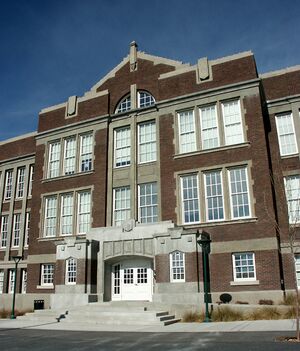
By 1900, Albuquerque boasted a population of 8,000 inhabitants and all the modern amenities, including an electric street railway connecting Old Town, New Town, and the recently established University of New Mexico campus on the East Mesa. In 1902, the famous Alvarado Hotel was built adjacent to the new passenger depot, and it remained a symbol of the city until it was razed in 1970 to make room for a parking lot. In 2002, the Alvarado Transportation Center was built on the site in a manner resembling the old landmark. The large metro station functions as the downtown headquarters for the city's transit department. It also serves as an intermodal hub for local buses, Greyhound buses, Amtrak passenger trains, and the Rail Runner commuter rail line.
New Mexico's dry climate brought many tuberculosis patients to the city in search of a cure during the early 20th century, and several sanitaria sprang up on the West Mesa to serve them. Presbyterian Hospital and St. Joseph Hospital, two of the largest hospitals in the Southwest, had their beginnings during this period. Influential New Deal–era governor Clyde Tingley and famed Southwestern architect John Gaw Meem were among those brought to New Mexico by tuberculosis.

The first travelers on Route 66 appeared in Albuquerque in 1926, and before long, dozens of motels, restaurants, and gift shops had sprung up along the roadside to serve them. Route 66 originally ran through the city on a north–south alignment along Fourth Street, but in 1937 it was realigned along Central Avenue, a more direct east–west route. The intersection of Fourth and Central downtown was the principal crossroads of the city for decades. The majority of the surviving structures from the Route 66 era are on Central, though there are also some on Fourth. Signs between Bernalillo and Los Lunas along the old route now have brown, historical highway markers denoting it as Pre-1937 Route 66.
The establishment of Kirtland Air Force Base in 1939, Sandia Base in the early 1940s, and Sandia National Laboratories in 1949, would make Albuquerque a key player of the Atomic Age. Meanwhile, the city continued to expand outward into the Northeast Heights, reaching a population of 201,189 by 1960. In 1990, it was 384,736 and in 2007 it was 518,271. In June 2007, Albuquerque was listed as the sixth fastest-growing city in the United States.[24] In 1990, the U.S. Census Bureau reported Albuquerque's population as 34.5% Hispanic and 58.3% non-Hispanic white.[25]
On April 11, 1950, a USAF B-29 bomber carrying a nuclear weapon crashed into a mountain near Manzano Base.[26] On May 22, 1957, a B-36 accidentally dropped a Mark 17 nuclear bomb 4.5 miles from the control tower while landing at Kirtland Air Force Base. Only the conventional trigger detonated, the bomb being unarmed. These incidents were classified for decades.[27]
Albuquerque's downtown entered the same phase and development (decline, "urban renewal" with continued decline, and gentrification) as nearly every city across the United States. As Albuquerque spread outward, the downtown area fell into a decline. Many historic buildings were razed in the 1960s and 1970s to make way for new plazas, high-rises, and parking lots as part of the city's urban renewal phase. اعتبارا من 2010[تحديث], only recently has Downtown Albuquerque come to regain much of its urban character, mainly through the construction of many new loft apartment buildings and the renovation of historic structures such as the KiMo Theater, in the gentrification phase.
During the 21st century, Albuquerque's population has continued to grow rapidly. The population of the city proper was estimated at 528,497 in 2009, up from 448,607 in the 2000 census.[28] During 2005 and 2006, the city celebrated its tricentennial with a diverse program of cultural events.
The passage of the Planned Growth Strategy in 2002–2004 was the community's strongest effort to create a framework for a more balanced and sustainable approach to urban growth.[29]
Urban sprawl is limited on three sides—by the Sandia Pueblo to the north, the Isleta Pueblo and Kirtland Air Force Base to the south, and the Sandia Mountains to the east. Suburban growth continues at a strong pace to the west, beyond the Petroglyph National Monument, once thought to be a natural boundary to sprawl development.[30]
Because of less-costly land and lower taxes, much of the growth in the metropolitan area is taking place outside of the city of Albuquerque itself. In Rio Rancho to the northwest, the communities east of the mountains, and the incorporated parts of Valencia County, population growth rates approach twice that of Albuquerque. The primary cities in Valencia County are Los Lunas and Belen, both of which are home to growing industrial complexes and new residential subdivisions. The mountain towns of Tijeras, Edgewood, and Moriarty, while close enough to Albuquerque to be considered suburbs, have experienced much less growth compared to Rio Rancho, Bernalillo, Los Lunas, and Belen. Limited water supply and rugged terrain are the main limiting factors for development in these towns. The Mid Region Council of Governments (MRCOG), which includes constituents from throughout the Albuquerque area, was formed to ensure that these governments along the middle Rio Grande would be able to meet the needs of their rapidly rising populations. MRCOG's cornerstone project is currently the New Mexico Rail Runner Express. In October 2013, the Albuquerque Journal reported Albuquerque as the third best city to own an investment property.[31]
الجغرافيا
Located in north-central New Mexico, Albuquerque serves as the county seat of Bernalillo County.[32] To its east are the Sandia–Manzano Mountains. The Rio Grande flows north to south through its center, while the West Mesa and Petroglyph National Monument make up the western part of the city. Albuquerque has one of the highest elevations of any major city in the U.S., ranging from 4،900 أقدام (1،500 m) above sea level near the Rio Grande to over 6،700 أقدام (2،000 m) in the foothill areas of Sandia Heights and Glenwood Hills. The civic apex is found in an undeveloped area within the Albuquerque Open Space; there, the terrain rises to an elevation of approximately 6،880 أقدام (2،100 m), and the metropolitan area's highest point is Sandia Crest at an altitude of 10،678 أقدام (3،255 m).
According to the United States Census Bureau, Albuquerque has a total area of 189.5 ميل مربع (490.9 km2), of which 187.7 ميل مربع (486.2 km2) is land and 1.8 ميل مربع (4.7 km2), or 0.96%, is water.[33]
Albuquerque lies within the fertile Rio Grande Valley with its Bosque forest, in the center of the Albuquerque Basin, flanked on the eastern side by the Sandia Mountains and to the west by the West Mesa.[34][35] Located in central New Mexico, the city also has noticeable influences from the adjacent Colorado Plateau semi-desert, New Mexico Mountains forested with juniper and pine, and Southwest plateaus and plains steppe ecoregions, depending on where one is located.
التضاريس والصرف
Albuquerque has one of the highest and most varied elevations of any major city in the United States, though the effects of this are greatly tempered by its southwesterly continental position. The elevation of the city ranges from 4,900 feet (1,490 m) above sea level near the Rio Grande (in the Valley) to over 6,700 feet (1,950 m) in the foothill areas of Sandia Heights and Glenwood Hills. At the Albuquerque International Sunport, the elevation is 5,352 feet (1,631 m) above sea level.
The Rio Grande is classified, like the Nile, as an "exotic" river. The New Mexico portion of the Rio Grande lies within the Rio Grande Rift Valley, bordered by a system of faults, including those that lifted up the adjacent Sandia and Manzano Mountains, while lowering the area where the life-sustaining Rio Grande now flows.
الجيولوجيا والبيئة
Albuquerque lies in the Albuquerque Basin, a portion of the Rio Grande rift.[36] The Sandia Mountains are the predominant geographic feature visible in Albuquerque. Sandía is Spanish for "watermelon", and is popularly believed to be a reference to the brilliant pink and green coloration of the mountains at sunset. The pink is due to large exposures of granodiorite cliffs, and the green is due to large swaths of conifer forests. However, Robert Julyan notes in The Place Names of New Mexico, "the most likely explanation is the one believed by the Sandia Pueblo Indians: the Spaniards, when they encountered the Pueblo in 1540, called it Sandia, because they thought the squash growing there were watermelons, and the name Sandia soon was transferred to the mountains east of the pueblo."[37] He also notes that the Sandia Pueblo Indians call the mountain Bien Mur, "big mountain."[37]
The Sandia foothills, on the west side of the mountains, have soils derived from that same rock material with varying sizes of decomposed granite, mixed with areas of clay and caliche (a calcium carbonate deposit common in the arid southwestern USA), along with some exposed granite bedrock.
Below the foothills, the area usually called the "Northeast Heights" consists of a mix of clay and caliche soils, overlaying a layer of decomposed granite, resulting from long-term outwash of that material from the adjacent mountains. This bajada is quite noticeable when driving into Albuquerque from the north or south, due to its fairly uniform slope from the mountains' edge downhill to the valley. Sand hills are scattered along the I-25 corridor and directly above the Rio Grande Valley, forming the lower end of the Heights.
The Rio Grande Valley, due to long-term shifting of the actual river channel, contains layers and areas of soils varying between caliche, clay, loam, and even some sand. It is the only part of Albuquerque where the water table often lies close to the surface, sometimes less than 10 أقدام (3.0 m).
The last significant area of Albuquerque geologically is the West Mesa: this is the elevated land west of the Rio Grande, including "West Bluff", the sandy terrace immediately west and above the river, and the rather sharply defined volcanic escarpment above and west of most of the developed city. The west mesa commonly has soils often referred to as "blow sand", along with occasional clay and caliche and even basalt, nearing the escarpment.
Scrub and mesa vegetation such as sagebrush (Artemisia filifolia), fourwing saltbush (Atriplex canescens), Indian ricegrass (Oryzopsis hymenoides), sand dropseed (Sporobolus cryptandrus), and mesa dropseed (Sporobolus flexuosus) is often found in sandy soils. Arroyos contain desert willow (Chilopsis linearis) while breaks and the prominent volcanic escarpment include threeleaf sumac with less frequent stands of oneseed juniper (Juniperus monosperma), netleaf hackberry (Celtis reticulata), mariola (Parthenium incanum), and beebrush or oreganillo (Aloysia wrightii). Isolated littleleaf sumac (Rhus microphylla) occurs on the hillsides above Taylor Ranch and at the Petroglyph National Monument Visitor's Center.
In the bosque are the eponymous Rio Grande cottonwood (Populus deltoides var. wislizeni), coyote willow (Salix exigua), mesquite or tornillo (Prosopis pubescens), Gooding's willow (Salix goodingii), and saint sacaton (Sporobulus wrightii). Other trees native to the bosque include, New Mexico olive (Forestiera pubescens var. neomexicana), New Mexico walnut (Juglans major), and New Mexico ash (Fraxinus velutina). Non-native plants such as Siberian elm, Russian olive, saltcedar, mulberries, Ailanthus, and ravenna grass also exist in large quantities.
The mountainous parts of the city feature piñon pine, desert live oak (Quercus turbinella), gray oak (Quercus grisea), hairy mountain mahogany (Cercocarpus breviflorus), oneseed juniper (Juniperus monosperma), piñon (Pinus edulis), threeleaf sumac (Rhus trilobata), Engelmann prickly pear (Opuntia engelmannii), juniper prickly pear (Opuntia hystricina var. juniperiana), and beargrass (Nolina greenei, formerly considered Nolina texana).
Native birds such as the greater roadrunner thrive in the city. Other birds include the common raven, American crow, great-tailed grackle, Gambel's and scaled quail, several species of hummingbirds, house finch, robin, pigeon, mourning dove, white wing and European collared doves (both recent appearances), curve-billed thrasher, pinyon jay, and Cooper's, Swainson's, and red-tail hawks. The valley hosts sandhill cranes each winter.
Other fauna include reptilia and amphibia such as the southwestern fence lizard and New Mexico whiptail (Aspidoscelis neomexicanus), rattlesnake, the New Mexico garter snake, the bullsnake, Woodhouse toads, New Mexico spadefoot toads, and tadpole shrimp ("Triops"). As well as arthropods like the plains cicada, vinegaroon, desert centipede, white-lined sphynx (hummingbird moth), two-tailed swallowtail, fig beetle, New Mexico mantis, and harvester ant.
أفق المدينة
الأرباع
Albuquerque is geographically divided into four quadrants that are officially part of mailing addresses. They are NE (northeast), NW (northwest), SE (southeast), and SW (southwest). The north–south dividing line is Central Avenue (the path that Route 66 took through the city), and the east–west dividing line is the Rail Runner tracks.
الشمال الشرقي
This quadrant has been experiencing a housing expansion since the late 1950s. It abuts the base of the Sandia Mountains and contains portions of the foothills neighborhoods, which are significantly higher, in elevation and price range, than the rest of the city. Running from Central Avenue and the railroad tracks to the Sandia Peak Aerial Tram, this is the largest quadrant both geographically and by population. Martineztown, the University of New Mexico, the Maxwell Museum of Anthropology, Nob Hill, the Uptown area which includes three shopping malls (Coronado Center, ABQ Uptown, and Winrock Town Center), Hoffmantown, Journal Center, Cliff's Amusement Park, and Balloon Fiesta Park are all in this quadrant.
Some of the most affluent neighborhoods in the city are here, including: High Desert, Tanoan, Sandia Heights, and North Albuquerque Acres. Parts of Sandia Heights and North Albuquerque Acres are outside the city limits proper. A few houses in the farthest reach of this quadrant lie in the Cibola National Forest, just over the line into Sandoval County.
الشمال الغربي

This quadrant contains historic Old Town Albuquerque, which dates to the 18th century, as well as the Indian Pueblo Cultural Center. The area has a mixture of commercial districts and low to high-income neighborhoods. Northwest Albuquerque includes the largest section of Downtown, Rio Grande Nature Center State Park and the Bosque ("woodlands"), Petroglyph National Monument, Double Eagle II Airport, the Paradise Hills neighborhood, Taylor Ranch, and Cottonwood Mall.
This quadrant also contains the North Valley settlement, outside the city limits, which has some expensive homes and small ranches along the Rio Grande. The city of Albuquerque engulfs the village of Los Ranchos de Albuquerque. A small portion of the rapidly developing area on the west side of the river south of the Petroglyphs, known as the "West Mesa" or "Westside", consisting primarily of traditional residential subdivisions, also extends into this quadrant. The city proper is bordered on the north by the North Valley, the village of Corrales, and the city of Rio Rancho.
الجنوب الشرقي
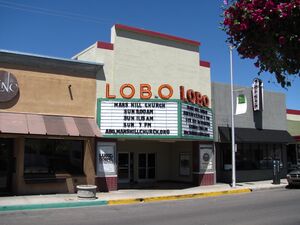
Kirtland Air Force Base, Sandia National Laboratories, Sandia Science & Technology Park, the Max Q commercial district, Albuquerque International Sunport, American Society of Radiologic Technologists, Central New Mexico Community College, UNM South Campus, Duke City BMX, University Stadium, Rio Grande Credit Union Field at Isotopes Park, The Pit, Mesa del Sol, Isleta Amphitheater, Netflix Studios, Isleta Resort & Casino, the National Museum of Nuclear Science & History, New Mexico Veterans Memorial, and Talin Market are all located in the Southeast quadrant of Albuquerque.
The southern half of the International District lies along Central Ave and Louisiana Blvd. Here, many immigrant communities have settled and thrive, having established numerous businesses. Albuquerque’s Vietnamese American community is partly business-centered in this area, as well as the Eubank, Juan Tabo, and Central areas, and other parts of Albuquerque. There is also a Laotian American temple and a sizable community in parts of this area as well as around Uptown. There is also an African American community around Highland.
The Four Hills neighborhoods are located in and around the foothills on the outskirts of Southeast Albuquerque. The vast newer subdivision of Volterra lies west of the Four Hills area. Popular urban neighborhoods that can be found in Southeast Albuquerque include Nob Hill, Ridgecrest, Parkland Hills, Hyder Park, and University Heights.
الجنوب الغربي
Traditionally consisting of agricultural and rural areas and suburban neighborhoods, the Southwest quadrant comprises the south-end of Downtown Albuquerque, the Barelas neighborhood, the rapidly growing west side, and the community of South Valley, New Mexico, often called "The South Valley". The quadrant extends all the way to the Isleta Indian Reservation. Newer suburban subdivisions on the West Mesa near the southwestern city limits join homes of older construction, some dating as far back as the 1940s. This quadrant includes the old communities of Atrisco, Los Padillas, Huning Castle, Kinney, Westgate, Westside, Alamosa, Mountainview, and Pajarito. The Bosque ("woodlands"), the National Hispanic Cultural Center, the Rio Grande Zoo, and Tingley Beach are also here.
A new adopted development plan, the Santolina Master Plan, will extend development on the west side past 118th Street SW to the edge of the Rio Puerco Valley and house 100,000 by 2050.[38]
المناخ
| ألبوكركه | ||||||||||||||||||||||||||||||||||||||||||||||||||||||||||||
|---|---|---|---|---|---|---|---|---|---|---|---|---|---|---|---|---|---|---|---|---|---|---|---|---|---|---|---|---|---|---|---|---|---|---|---|---|---|---|---|---|---|---|---|---|---|---|---|---|---|---|---|---|---|---|---|---|---|---|---|---|
| جدول الطقس (التفسير) | ||||||||||||||||||||||||||||||||||||||||||||||||||||||||||||
| ||||||||||||||||||||||||||||||||||||||||||||||||||||||||||||
| ||||||||||||||||||||||||||||||||||||||||||||||||||||||||||||
أفق المدينة
هذه section بحاجة لمصادر إضافية لتحسين وثوقيتها. (September 2008) |
العمارة

| Name | Height | Floors |
|---|---|---|
| Bank of Albuquerque Tower | 351 feet (107 m) | 22 |
| Hyatt Regency Albuquerque | 256 feet (78 m) | 21 |
| Compass Bank Building | 238 feet (73 m) | 18 |
| Albuquerque Petroleum Building | 235 feet (72 m) | 15 |
| Bank of the West Tower | 213 feet (65 m) | 17 |
| Gold Building | 203 feet (62 m) | 14 |
| Dennis Chavez Federal Building | 197 feet (60 m) | 13 |
| PNM Building | 184 feet (56 m) | 12 |
| Simms Building | 180 feet (55 m) | 13 |
| Pete V. Domenici U.S. Courthouse | 176 feet (54 m) | 7 |
الاقتصاد
Albuquerque is New Mexico's leading economic center, accounting for half the state's economic activity.[39] The city's economy is highly diversified, centering on science, medicine, technology, commerce, education, media entertainment, and culture (particularly fine arts); construction, film production, and retail trade have seen the most robust growth since 2020.[40]
Albuquerque is the center of the New Mexico Technology Corridor, a concentration of institutions engaged in scientific research and development, which in turn forms part of the larger Rio Grande Technology Corridor that that stretches from southern Colorado to southwestern Texas.[41] Major nodes within the corridor include federal installations such as Kirtland Air Force Base, Los Alamos National Laboratory, and Sandia National Laboratories; private healthcare facilities such as Lovelace Respiratory Research Institute and Presbyterian Health Services; academic institutions such as the University of New Mexico and Central New Mexico Community College; and private companies such as Intel (which has a fabrication site in neighboring Rio Rancho), Facebook (with a data center in Los Lunas), Northrop Grumman, passive solar energy company Zomeworks, and Tempur-Pedic. The city was also the founding location of MITS and Microsoft.
Beginning with the Manhattan Project in the 1940s, federal labs such as Los Alamos, Sandia, and Lawrence Livermore National Laboratory have cooperated on multidisciplinary research in the region; contractors for these facilities bring highly educated workers and researchers to an otherwise relatively isolated area, many of whom establish or work with local tech companies. The federal government spends roughly $4 billion annually in research and development in and around Albuquerque. Pursuant to the CHIPS and Science Act—federal legislation aimed at expanding domestic semiconductor manufacturing, research and development of new technology, and workforce training—the U.S. Department of Energy announced plans to construct a new 100,000-square-foot technology incubator for companies, academia, and national laboratories, as well as a new platform for facilitating the development of tech startups among minority communities.[42]
The governments of Albuquerque and New Mexico have sought to attract more private investment into technology startups.[43] The bioscience sector has experienced particularly robust growth, beginning with the 2013 opening of a BioScience Center in Uptown Albuquerque, which was the state's first private incubator for biotechnology startups; since then, New Mexico-based scientists have formed roughly 150 bioscience startups, many of which are based in the Albuquerque metropolitan area.[44] In 2017, the state-funded Bioscience Authority was established to help promote local industry development, particularly through public-private partnerships; the following year, pharmaceutical company Curia built two large facilities in Albuquerque, and in fall 2022 broke ground on a $100 million expansion of its local operations.[44]
Film studios have a major presence throughout New Mexico; Netflix maintains a major production hub at Albuquerque Studios. There are numerous shopping centers and malls within the city, including ABQ Uptown, Coronado, Cottonwood, Nob Hill, and Winrock. Outside city limits but surrounded by the city is a horse racing track and casino called The Downs Casino and Racetrack, and the pueblos surrounding the city feature resort casinos, including Sandia Resort, Santa Ana Star, Isleta Resort, and Laguna Pueblo's Route 66 Resort.
| 1 | Kirtland Air Force Base |
| 2 | University of New Mexico |
| 3 | Sandia National Laboratories |
| 4 | Albuquerque Public Schools |
| 5 | Presbyterian Healthcare Services |
| 6 | City of Albuquerque (Government) |
| 7 | Lovelace–Sandia Health System |
| 8 | Presbyterian Medical Services |
| 9 | Intel Corporation |
| 10 | State of New Mexico (Government) |
| 11 | Wal-Mart Stores, Inc. |
Forbes magazine rated Albuquerque the best city in America for business and careers in 2006,[45] and as the 13th best (out of 200 metro areas) in 2008.[46] The city ranked seventh among America's Engineering Capitals in 2014 by Forbes.[47] Albuquerque was named one of the "Top 10 Best Cities to Live" by U.S. News & World Report in 2009[48] and was recognized as the fourth best place to live for families by the TLC network.[49] It was ranked among the Top Best Cities for Jobs in 2007 and among the Top 50 Best Places to Live and Play by National Geographic Adventure.[50][51]
الديمغرافيا
| التعداد تاريخياً | |||
|---|---|---|---|
| الإحصاء | التعداد | %± | |
| 1890 | 3٬785 | ||
| 1900 | 6٬238 | 64.8% | |
| 1910 | 11٬020 | 76.7% | |
| 1920 | 15٬157 | 37.5% | |
| 1930 | 26٬570 | 75.3% | |
| 1940 | 35٬449 | 33.4% | |
| 1950 | 96٬815 | 173.1% | |
| 1960 | 201٬189 | 107.8% | |
| 1970 | 244٬501 | 21.5% | |
| 1980 | 332٬920 | 36.2% | |
| 1990 | 384٬736 | 15.6% | |
| 2000 | 448٬607 | 16.6% | |
| تقديري 2007 | 518٬271 | [52] | 15.5% |
| Sources: 1890-1990[53], 2000[54] | |||
الرياضة
| Club | Sport | League | Venue | Capacity |
|---|---|---|---|---|
| Albuquerque Isotopes | Baseball | AAA PCL | Isotopes Park | 12,050 |
| Albuquerque Thunderbirds | Basketball | NBA D-League | Tingley Coliseum | 11,200 |
| New Mexico Scorpions | AA Minor League Ice Hockey | CHL | Santa Ana Star Center | 8,000 |
| New Mexico Wildcats | Indoor football | AIFA | Santa Ana Star Center | 7,500 |
| University of New Mexico Lobos | NCAA Division I Football | Mountain West Conference | University Stadium | 41,000 |
| University of New Mexico Lobos | NCAA Division I Men's and Women's Basketball | Mountain West Conference | University Arena(also known as The Pit) | 18,018 |
الحكومة
| Mayor | Martin J. Chávez |
| President of the Council | Isaac Benton (since 2008)[57] |
| Vice-President of the Council | Sally Mayer (since 2008)[57] |
| District 1 | Ken Sánchez |
| District 2 | Debbie O'Malley |
| District 3 | Isaac Benton |
| District 4 | Bradley Winter |
| District 5 | Michael J. Cadigan |
| District 6 | Rey Garduño |
| District 7 | Sally Mayer |
| District 8 | Trudy Jones |
| District 9 | Don Harris |
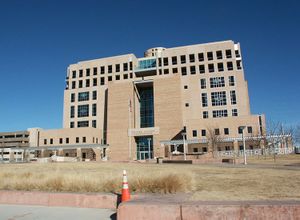
Albuquerque is a charter city[58].
البنية التحتية
المواصلات
المدن الشقيقة
Albuquerque لها eleven مدن شقيقة، حسب توصيف المدن الشقيقة الدولية: [59]
انظر أيضاً
- List of municipalities in New Mexico
- National Old Trails Road
- Breaking Bad and Better Call Saul, TV shows set in Albuquerque
ملاحظات
- ^ Spanish also Alburquerque النطق الإسپاني: [alβuɾˈkeɾke]. قالب:Lang-nv قالب:IPA-nv; قالب:Lang-kee; قالب:Lang-tow; قالب:Lang-zun; قالب:Lang-apj.
- ^ The Spanish town name is believed to stem from the Latin alba quercus which translates in English as "white oak"
المصادر
- ^ "ArcGIS REST Services Directory". United States Census Bureau. Retrieved October 12, 2022.
- ^ أ ب U.S. Geological Survey Geographic Names Information System: ألباكركي، نيو مكسيكو
- ^ خطأ استشهاد: وسم
<ref>غير صحيح؛ لا نص تم توفيره للمراجع المسماةUSCensusDecennial2020CenPopScriptOnly - ^ "2020 Population and Housing State Data". United States Census Bureau. Retrieved 22 August 2021.
- ^ "U.S. Census Bureau QuickFacts: Albuquerque city, New Mexico". Census Bureau QuickFacts. Archived from the original on September 15, 2018. Retrieved September 15, 2018.
- ^ "30 Interesting Facts About Albuquerque". Isolated Traveller. October 6, 2021. Retrieved May 17, 2022.
- ^ "QuickFacts: Albuquerque city, New Mexico". United States Census Bureau. Retrieved 24 August 2021.
- ^ "Combined Statistical Areas - 2020 Census - Data as of January 1, 2020". TIGERweb Redirect. January 1, 2020. Retrieved May 17, 2022.
- ^ Shankland, Stephen (May 3, 2021). "Intel investing $3.5B in New Mexico fab upgrade, boosting US chipmaking". CNET. Retrieved May 17, 2022.
- ^ "Making Movies in the 505". ABQ Film Office. January 1, 2010. Retrieved May 17, 2022.
- ^ "Historic Landmarks". City of Albuquerque. March 14, 2022. Retrieved May 17, 2022.
- ^ "An Albuquerque Appetite: Where to Eat in New Mexico's Biggest City". Food Com. May 24, 2018. Retrieved May 17, 2022.
- ^ Barrett, Elinore M. (2002). Conquest and Catastrophe: Changing Rio Grande Pueblo Settlement Patterns in the Sixteenth and Seventeenth Centuries (in الإنجليزية). Albuquerque: UNM Press. ISBN 9780826324139. Retrieved September 25, 2017 – via Google Books.
- ^ "History of Sandia Pueblo". Sandia Pueblo website. Pueblo of Sandia. 2006. Archived from the original on January 2, 2008. Retrieved January 17, 2008.
- ^ Seymour, Deni (2012). From the Land of Ever Winter to the American Southwest. University of Utah Press.
- ^ "About – Albuquerque Historical Society". Albuquerque Historical Society. Archived from the original on December 19, 2015. Retrieved January 4, 2016.
- ^ "History". Nmallstar.com. Archived from the original on March 25, 2012. Retrieved February 18, 2012.
- ^ New Mexico Department of Cultural Affairs, Historic Preservation Division. "San Felipe de Neri Church Historical Marker". Archived from the original on May 13, 2013. Retrieved December 5, 2012.
- ^ Richardson, Albert D. (1867). Beyond the Mississippi: From the Great River to the Great Ocean. Hartford, Conn.: American Publishing Co. p. 249.
- ^ Galloway, Lindsey. "A hospital turned hotel in New Mexico". BBC Travel. Archived from the original on May 11, 2017. Retrieved July 15, 2017.
- ^ Fogel, Gary (2021). Sky Rider: Park Van Tassel and the Rise of Ballooning in the West. Albuquerque: University of New Mexico Press. ISBN 978-0-8263-6282-7.
- ^ Simmons, Marc (1982). Albuquerque. Albuquerque: University of New Mexico Press. ISBN 0-8263-0627-6.
- ^ "Home". congregationalbert.org. Archived from the original on June 12, 2015. Retrieved June 14, 2015.
- ^ Les Christie (June 28, 2007). "The fastest growing U.S. cities – June 28, 2007". CNN. Archived from the original on April 4, 2013. Retrieved May 9, 2009.
- ^ "Race and Hispanic Origin for Selected Cities and Other Places: Earliest Census to 1990". U.S. Census Bureau. Archived from the original on September 12, 2008. Retrieved April 23, 2012.
- ^ Tiwari J, Gray CJ. "U.S. Nuclear Weapons Accidents". Archived from the original on April 23, 2012.
- ^ Adler, Les. "Albuquerque's Near-Doomsday." Archived مايو 15, 2019 at the Wayback Machine Albuquerque Tribune. January 20, 1994.
- ^ Siermers, Erick (September 17, 2007). "Managing Albuquerque's growth". Archived from the original on February 22, 2010. Retrieved September 17, 2007.
- ^ "Planned Growth Strategy". Cabq.gov. March 19, 2007. Archived from the original on May 17, 2008. Retrieved July 2, 2010.
- ^ "Petroglyph National Monument". Nps.gov. June 10, 2010. Archived from the original on August 28, 2010. Retrieved July 2, 2010.
- ^ Metcalf, Richard. "ABQ third-best metro for making money owning rental housing." Albuquerque Journal. October 7, 2013.
- ^ "Find a County". National Association of Counties. Archived from the original on May 31, 2011. Retrieved June 7, 2011.
- ^ "Geographic Identifiers: 2010 Demographic Profile Data (G001): Albuquerque city, New Mexico". U.S. Census Bureau, American Factfinder. Archived from the original on February 12, 2020. Retrieved January 27, 2014.
- ^ Laura Calabrese. "Vegetation & The Environment in NM". University of New Mexico. Archived from the original on December 11, 2013. Retrieved July 24, 2012.
- ^ Stephen Ausherman (2012). 60 Hikes Within 60 Miles: Albuquerque: Including Santa Fe, Mount Taylor, and San Lorenzo Canyon (2nd ed.). Menasha Ridge Press. p. 288. ISBN 9780897326001. Archived from the original on February 4, 2016. Retrieved November 12, 2015.
- ^ "Albuquerque Basin". The New Mexico Bureau of Geology & Mineral Resources. Archived from the original on November 7, 2012. Retrieved September 28, 2012.
- ^ أ ب Robert Julyan, The Place Names of New Mexico (revised edition), UNM Press, 1998.
- ^ "Adopted Santolina Level A Master Plan-Bernalillo County, New Mexico". bernco.gov. Archived from the original on September 7, 2016. Retrieved September 5, 2016.
- ^ "Albuquerque, NM Economy at a Glance". www.bls.gov (in الإنجليزية). Retrieved 2022-12-27.
- ^ "Albuquerque Economy Showing Remarkable Growth, August GRT Data Just Released". City of Albuquerque (in الإنجليزية). Retrieved 2022-12-27.
- ^ Caregiver, Electronic. "Will The Rio Grande Tech Corridor Become The Silicon Valley Of New Mexico?". www.prnewswire.com (Press release) (in الإنجليزية). Retrieved 2022-12-27.
- ^ Monson, Mary. "Opportunities knocking for NM tech economy". Albuquerque Journal.
- ^ "New Mexico scientists have formed nearly 150 bioscience startups in just the past 10 years. The rest of the country is starting to notice. - Albuquerque Journal". www.abqjournal.com. Retrieved 2023-01-16.
- ^ أ ب "New jobs, bigger facilities, local support: New Mexico's bioscience industry is alive and kicking - Albuquerque Journal". www.abqjournal.com. Retrieved 2023-01-16.
- ^ "Best Places For Business And Careers 2006". Forbes. January 1, 2006. Archived from the original on March 12, 2009. Retrieved January 20, 2009.
- ^ "Best Places For Business And Careers". Forbes. March 19, 2008. Archived from the original on January 22, 2009. Retrieved December 23, 2008.
- ^ "America's Engineering Capitals: No. 7, Albuquerque, NM". Forbes. Archived from the original on March 13, 2018. Retrieved August 23, 2017.
- ^ "Best Places to Live 2009". Archived from the original on July 20, 2014. Retrieved July 15, 2014.
- ^ "Top 10 Cities for Families". 2011. Archived from the original on July 19, 2014. Retrieved July 15, 2014.
- ^ Kurdahy, Matthew (October 12, 2007). "Top 10 Cities for Jobs". Forbes. Archived from the original on March 13, 2018. Retrieved August 23, 2017.
- ^ Koeppel, Dan (September 2007). "Best Places to Live + Play: Cities". National Geographic Adventure. Archived from the original on April 16, 2008.
- ^ خطأ استشهاد: وسم
<ref>غير صحيح؛ لا نص تم توفيره للمراجع المسماةCensus PopEst over 100,000 2007 - ^ "Table 46. Population Rank of Incorporated Places of 100,000 Population or More, 1990; Population, 1790 to 1990; Housing Units: 1940 to 1990". Population and Housing Unit Counts (PDF). 1990 Census of Population and Housing. Vol. CPH-2-1. U. S. Department of Commerce, Bureau of the Census. pp. 593–594. Retrieved 2008-07-03.
- ^ "Population Estimates for All Places: 2000 to 2006". US Census Bureau, Population Division. 2007-06-29. Retrieved 2008-06-24.
- ^ "Mayor Martin J. Chávez". City of Albuquerque. Retrieved 26 December 2008.
- ^ "Albuquerque City Councilors". City of Albuquerque. Retrieved 26 December 2008.
- ^ أ ب خطأ استشهاد: وسم
<ref>غير صحيح؛ لا نص تم توفيره للمراجع المسماةCouncil 2008 President - ^ "Charter of the City of Albuquerque". American Legal Publishing Corporation. Retrieved 26 December 2008.
- ^ "Albuquerque Sister Cities". City of Albuquerque. Archived from the original on November 19, 2018. Retrieved November 1, 2020.
وصلات خارجية
- Official website
- 1905 Magazine Article with historical photos
- ألباكركي، نيو مكسيكو at Curlie
- "Albuquerque, New Mexico". C-SPAN Cities Tour. March 2013.
قالب:Albuquerque قالب:Bernalillo County, New Mexico
قالب:New Mexico cities and mayors of 100,000 population قالب:New Mexico county seats
- Pages using gadget WikiMiniAtlas
- Articles containing إسپانية-language text
- Articles with hatnote templates targeting a nonexistent page
- Short description is different from Wikidata
- Pages using multiple image with auto scaled images
- Coordinates on Wikidata
- صفحات تستخدم جدول مستوطنة بقائمة محتملة لصفات المواطن
- Articles containing إنگليزية-language text
- Pages using Lang-xx templates
- Pages including recorded pronunciations
- مقالات فيها عبارات متقادمة منذ 2010
- جميع المقالات التي فيها عبارات متقادمة
- Articles needing additional references from September 2008
- All articles needing additional references
- Pages with empty portal template
- Official website different in Wikidata and Wikipedia
- Articles with Curlie links
- مدن تأسست في 1706
- ألبوكركي، نيو مكسيكو
- مدن نيو مكسيكو
- Cities in New Mexico
- Cities in Bernalillo County, New Mexico
- Albuquerque metropolitan area
- County seats in New Mexico
- Populated places established in 1706
- Spanish-American culture in New Mexico
- 1706 establishments in New Spain
- Railway towns in New Mexico
- New Mexico populated places on the Rio Grande
- صفحات مع الخرائط



